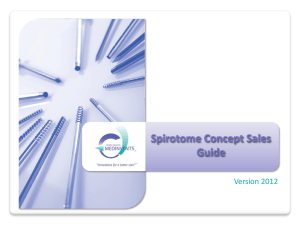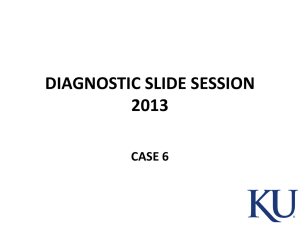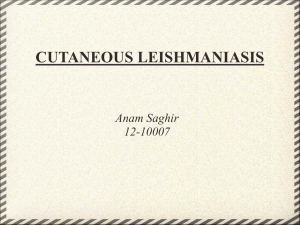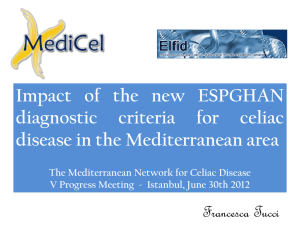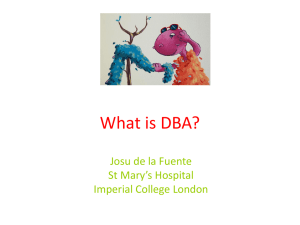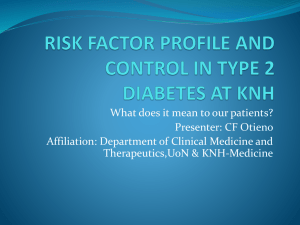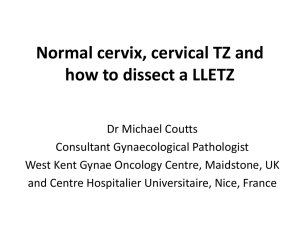utmj submission template - University of Toronto Medical Journal
advertisement
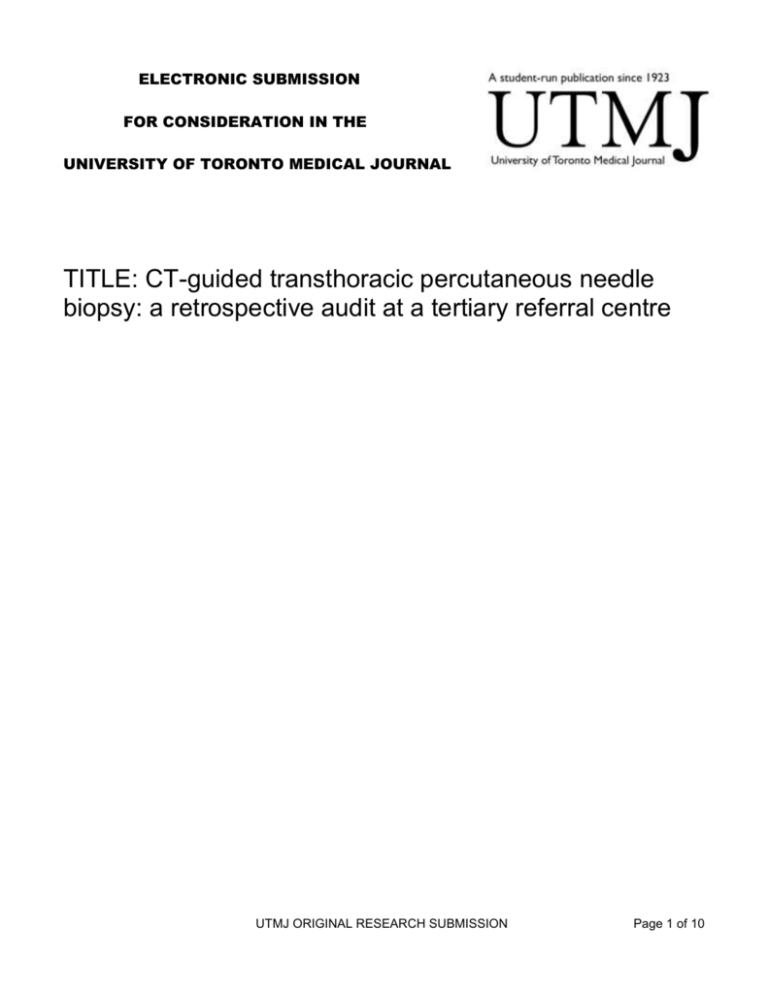
ELECTRONIC SUBMISSION FOR CONSIDERATION IN THE UNIVERSITY OF TORONTO MEDICAL JOURNAL TITLE: CT-guided transthoracic percutaneous needle biopsy: a retrospective audit at a tertiary referral centre UTMJ ORIGINAL RESEARCH SUBMISSION Page 1 of 10 PATRICK KENNEDY ABSTRACT The purpose of this audit is to determine the success and complication rates from computed tomography (CT)-guided transthoracic percutaneous needle biopsies (PNBs) in a tertiary referral centre and compare these with the Society of Interventional Radiology (SIR) standards of practice. Using the Picture Archiving and Communication System (PACS), all CT-guided transthoracic PNBs were isolated at St. Joseph’s Healthcare Hamilton (SJHH) for the year of 2010. Reports, images, or both were reviewed to determine the lesion size, lesion site, needle size, number of core biopsies obtained, and rates of complications. Post biopsy chest radiograph reports, images, or both were reviewed in some cases. Pathology, microbiology, and surgery results were also reviewed. Complication and diagnostic rates were then compared with published SIR standards of practice. Two hundred and fifty-eight CT-guided transthoracic PNBs were performed at SJHH in 2010, of which 226 (87.6%) were successful. One hundred and eight (41.9%) had minor complications, while none resulted in major complications. Thirtytwo (12.4%) biopsies were non-diagnostic. Six (2.3%) non-diagnostic biopsies were shown to be malignant by repeat biopsy or surgery. Three (1.2%) biopsies showed benign tissue but were proven malignant by repeat biopsy or surgery. In conclusion, CT guided transthoracic PNB is a safe and effective technique to obtain tissue diagnosis, however regular audits are necessary to improve outcomes and minimize complications. KEYWORDS: computed tomography; interventional; lung cancer; lung biopsy; quality assurance. INTRODUCTION St. Joseph’s Healthcare Hamilton (SJHH) is located in Hamilton, Ontario, Canada. It serves as a thoracic and respiratory tertiary referral centre for the Central West Region of Ontario, with a UTMJ ORIGINAL RESEARCH SUBMISSION Page 2 of 10 PATRICK KENNEDY population of 2.3 million people. Computed tomography (CT)-guided transthoracic percutaneous needle biopsy (PNB) is offered by the department of Diagnostic Imaging at SJHH. Transthoracic PNB is a minimally invasive diagnostic tool used primarily for the tissue diagnosis of lesions in the lung parenchyma, hilum, or mediastinum 1-2. It is also useful in establishing the cause of multiple pulmonary nodules, abscesses, and focal areas of consolidation 3. Although several imaging modalities are feasible, CT has become the most commonly used modality for guidance in these procedures4. In part, this is because CT allows for visualization and biopsy of lesions as small as 0.5 cm in diameter5. Further, its safety has been optimized with the use of contrast enhancement to avoid vascular structures and a coaxial technique to avoid multiple punctures6. The purpose of this audit is to ensure a high standard of care and to recognize institutionspecific rates of complications and diagnoses. The data may also be used to provide a more appropriate and accurate informed consent to patients at SJHH and similar institution. METHODS Upon research ethics board approval, all CT-guided transthoracic PNBs performed at SJHH in 2010 were retrospectively isolated using the Picture Archiving and Communication System (PACS). These biopsies were undertaken to examine lesions within the lung parenchyma, pleura, mediastinum, or chest wall, with indications in keeping with the SIR guidelines 7. Biopsy reports, images, or both were reviewed to determine rates and types of complications, lesion size (in long-axis dimension), lesion site, needle size, and number of core biopsies performed. Pathology, microbiology, and, in certain cases, post-biopsy chest radiographs, clinical notes, and operative reports were also reviewed. Complication and success rates were compared with published Society of Interventional Radiology (SIR) standards of practice, with UTMJ ORIGINAL RESEARCH SUBMISSION Page 3 of 10 PATRICK KENNEDY success being defined as a diagnostic biopsy result which is confirmed by repeat biopsy or surgery 7. RESULTS In 2010, a total of 258 CT-guided transthoracic PNBs were performed. One hundred and ninety-eight (76.7%) were performed for disease that was ultimately proven malignant, either by biopsy or subsequent surgery. All biopsies were performed by five radiologists (three interventional radiologists and two diagnostic radiologists trained to perform CT-guided lung biopsies). The biopsies were performed with CT guidance under local anesthetic, with a minority requiring intravenous sedation. The patients recovered in the day surgery unit following the procedure for two to three hours post-procedure. A follow-up chest radiograph was performed at one and two hours post-procedure to check for pneumothorax. In total, 226 (87.6%) biopsies were considered to be successful, while 32 (12.4%) were nondiagnostic. A repeat CT-guided PNB was required for 10 (3.9%) patients. These repeat biopsies were performed in cases where the lesion was concerning for malignancy on imaging but described as non-diagnostic or benign on the pathology report. Six (2.3%) non-diagnostic biopsies were shown to be malignant by repeat biopsy or surgery. Three (1.2%) biopsies showed benign tissue but were proven malignant by repeated biopsy or surgery. One hundred and eight (41.9%) biopsies performed had minor complications. Specifically, the number of occurrences of pneumothorax, thoracostomy tube placement, and mild haemorrhage were 28 (10.9%), 23 (8.9%), and 57 (22.1%), respectively. Of note, six of the 23 patients requiring a tube thoracostomy had no clinically or radiologically detectable pneumothorax after the biopsy. One patient was discharged home with a small stable pneumothorax and returned the next day with an enlarging pneumothorax requiring a tube thoracostomy. None of the UTMJ ORIGINAL RESEARCH SUBMISSION Page 4 of 10 PATRICK KENNEDY biopsies performed resulted in major complications. There were no deaths resulting from CTguided transthoracic PNB in our study. DISCUSSION Quality improvement (QI) guidelines for PNB have been produced by the SIR Standards of Practice Committee. According to these guidelines, 95% of PNBs should be performed to establish the benign or malignant nature of a lesion, to obtain material for microbiologic analysis in patients with known or suspected infections, to stage patients with known or suspected malignancy when local spread or distant metastasis is suspected, or to determine the nature and extent of certain diffuse parenchymal diseases. The suggested QI threshold for success rates of thoracic/pulmonary PNB is 75%7. Complications occurring as a result of transthoracic PNB are not uncommon. The SIR guidelines classify complications as either minor or major based on clinical outcome (Table 1). QI thresholds for specific complications are also provided (Table 2)7. Other complications such cardiac tamponade, malignant seeding along the needle tract, and massive haemothorax are not discussed as they are very rare and only described in case reports8-10. Table 1: SIR classification of complications by clinical outcome7. Minor Complications No therapy, no consequence Nominal therapy, no consequence; includes overnight admission for observation only Major Complications Require therapy, minor hospitalization (<48 hours) Require major therapy, unplanned increase level of care, prolonged hospitalization (>48 hours) Permanent adverse sequelae Death UTMJ ORIGINAL RESEARCH SUBMISSION Page 5 of 10 PATRICK KENNEDY The success and complication rates in our audit were within the acceptable QI thresholds suggested by the SIR7. As equipment and methodology continue to improve the practice of PNB, it is important for centres offering this procedure to fulfill an appropriate standard of care. This audit demonstrates that such a standard is being met at our institution. Table 2: Complications and suggested QI thresholds for transthoracic PNB7. Suggested QI thresholds Minor Complications Pneumothorax Thoracostomy tube placement Mild haemorrhage* 45% 20% Not reported Major Complications Haemoptysis requiring hospitalization or specific 2% therapy Thoracostomy tube placement requiring prolonged 3% admission, catheter exchange, or pleurodesis Air embolism <0.1% *This is not considered a complication in the SIR guidelines; however it was considered a minor complication in our study. Success rates are compared to the SIR standards in Table 3. Several other studies have also demonstrated the diagnostic power of transthoracic PNB11-16. Multiple factors may contribute to the occurrence of a non-diagnostic biopsy. Li and colleagues found that lesion size has a considerable effect on diagnostic accuracy, with accuracies of PNB for small nodules (<1.5cm in long-axis dimension) and large nodules of 74% and 96%, respectively15. Other contributing factors may include location of the lesion and operator experience 17. Note that the QI guidelines do not suggest a threshold for rates of non-diagnostic or benign biopsies that are ultimately shown to be malignant. These are important outcomes following PNB that have a significant impact on patient care. It may therefore be prudent to include these possible outcomes in future QI guidelines. UTMJ ORIGINAL RESEARCH SUBMISSION Page 6 of 10 PATRICK KENNEDY PNB7. Table 3: Success rates of CT-guided transthoracic Success Rates Biopsy success rate 87.6% Non-diagnostic biopsies which were 2.3% proven to be malignant by repeat biopsy or surgery Benign biopsies which were proven to 1.2% be malignant by repeat biopsy or surgery Suggested QI Threshold 75% Not reported Not reported Complication rates are compared to the SIR standards in Table 4. While a significant number of minor complications did occur in our study, the complication rates were well within the suggested QI thresholds7. Nevertheless, the possibility of such complications arising must be discussed with patients when they are considering the risks, benefits, and alternatives of CTguided transthoracic PNB. Table 4: Complication rates of CT-guided transthoracic PNB7. Complication Suggested QI Rates Threshold Major Complications Haemoptysis requiring hospitalization or specific therapy Thoracostomy tube placement requiring prolonged admission, catheter exchange, or pleurodesis Minor Complications Pneumothorax Thoracostomy tube placement Mild haemorrhage 0% 2% 0% 3% 10.9% 8.9% 22.1% 45% 20% Not recorded No major complications occurred in our study, nor did any of the biopsies undertaken result in death. Because of the paucity of cases actually resulting in death, the literature discussing the association with mortality is limited. However, one large study in the United Kingdom estimated UTMJ ORIGINAL RESEARCH SUBMISSION Page 7 of 10 PATRICK KENNEDY a mortality rate of 0.15%18. Possible causes of death include massive haemorrhage and large venous air embolism10, 19. In conclusion, the success and complication rates at our institution exceeded the standards suggested by the SIR7. Therefore, CT-guided transthoracic PNB has been reinforced as a safe and effective method for obtaining a tissue diagnosis. This is a retrospective single centre study and, thus, there are limitations in the applicability of its results. Nevertheless, institution-based data can now be offered to patients when providing informed consent. Such results can also be used for the same purpose at other similar institutions. Institution-specific clinical audits are most informative and valuable for patients undergoing this procedure. Regular audits are necessary at all centres providing this service to monitor for complications and improve outcomes. ACKNOWLEDGMENTS We would like to thank the radiologists who participated in this study and the rest of the staff in the Department of Diagnostic Imaging at Saint Joseph’s Healthcare Hamilton. CONFLICTS OF INTEREST We have no conflicts of interest to report. REFERENCES [1] Khouri NF, Stitik FP, Erozan YS, et al. Transthoracic needle aspiration biopsy of benign and malignant lung lesions. Am J Roentgenol. 1985 Feb;144:281-288. [http://www.ajronline.org/content/144/2/281.long] [2] Westcott JL. Percutaneous needle aspiration of hilar and mediastinal masses. Radiology. 1981 Nov;141(2):323-329. [http://radiology.rsna.org/content/141/2/323.long] UTMJ ORIGINAL RESEARCH SUBMISSION Page 8 of 10 PATRICK KENNEDY [3] Murphy JM, Gleeson FV, Flower CDR. Percutaneous needle biopsy of the lung and its impact on patient management. World J Surg. 2001 Apr;25:373-380. [http://www.springerlink.com/content/nn8jbym87pe1b45u/] [4] Birchard KR. Transthoracic needle biopsy. Semin Intervent Radiol. 2011 Mar;28(1):87-97. [http://www.ncbi.nlm.nih.gov/pmc/articles/PMC3140242/] [5] Mueller PR, vanSonnenberg E. Interventional radiology in the chest and abdomen. N Engl J Med. 1990 May;322(19):1364-1374. [http://www.nejm.org/doi/full/10.1056/NEJM199005103221906] [6] vanSonnenberg E, Lin AS, Deutsch AL, et al. Percutaneous biopsy of difficult mediastinal, hilar, and pulmonary lesions by computed tomographic guidance and a modified coaxial technique. Radiology. 1983 Jul;148(1):300-302. [http://radiology.rsna.org/content/148/1/300.long] [7] Gupta S, Wallace MJ, Cardella JF, et al. Quality improvement guidelines for percutaneous needle biopsy. J Vasc Interv Radiol. 2010 Jul;21:969-975. [http://www.sirweb.org/clinical/cpg/0810-5.pdf] [8] Kucharczyk W, Weisbrod GL, Cooper JD, et al. Cardiac tamponade as a complication of thin-needle aspiration lung biopsy. Chest. 1982 Jul;82:120-121. [9] Sinner WN, Zajicek J. Implantation metastasis after percutaneous transthoracic needle aspiration biopsy. Acta Radiol Diagn (Stockh). 1976 Jul;17(4):473-480. [10] Glassberg RM, Sussman SK. Life threatening hemorrhage due to percutaneous thoracic intervention: importance of the internal mammary artery. Am J Roentgenol. 1990 Jan;154:4749. [http://www.ajronline.org/content/154/1/47.full.pdf] [11] Pilotti S, Rilke F, Gribaudi G, et al. Transthoracic fine needle aspiration biopsy in pulmonary lesions. Updated results. Acta Cytol. 1984 May;28:225-232. UTMJ ORIGINAL RESEARCH SUBMISSION Page 9 of 10 PATRICK KENNEDY [12] Zarbo RJ, Fenaglio-Preiser CM. Interinstitutional database for comparison of performance in lung fine-needle aspiration cytology. A College of American Pathologists Q-probe study of 5264 cases with histologic correlation. Arch Pathol Lab Med. 1992 May;116:463-470. [http://www.cap.org/apps/docs/q_probes%2Fpast_studies%2F1992%2Flung_fineneedle_aspiration_cytology.pdf] [13] Charig MJ, Stutley JE, Padley SPG, et al. The value of negative needle biopsy in suspected operable lung cancer. Clin Radiol. 1991 Sep;44:147-149. [http://www.sciencedirect.com/science/article/pii/S0009926005808566] [14] Stanley JH, Fish GD, Andriole JG, et al. Lung lesions: cytologic diagnosis by fine-needle biopsy. Radiology. 1987 Feb;162(2):389-391. [http://radiology.rsna.org/content/162/2/389.long] [15] Li H, Boiselle PM, Shepard JO, et al. Diagnostic accuracy and safety of CT-guided percutaneous needle aspiration biopsy of the lung: comparison of small and large pulmonary nodules. Am J Roentgenol. 1996 Jul;167:105-109. [http://www.ajronline.org/content/167/1/105.long] [16] Greene R, Szyfelbein WM, Isler RJ, et al. Supplementary tissue-core histology from fineneedle transthoracic aspiration biopsy. Am J Roentgenol. 1985 Apr;144(4):787-792. [http://www.ajronline.org/content/144/4/787.long] [17] Moore EH. Technical aspects of needle aspiration biopsy: a personal perspective. Radiology. 1998 Aug;208:303-318. [http://radiology.rsna.org/content/208/2/303.long] [18] Richardson CM, Pointon KS, Manhire AR, et al. Percutaneous lung biopsies: a survey of UK practice based on 5444 biopsies. Br J Radiol. 2002 Sep;75:731-735. [http://bjr.birjournals.org/content/75/897/731.full.pdf+html] [19] Kodama F, Ogawa T, Hashimoto M, et al. Fatal air embolism as a complication of CTguided needle biopsy of the lung. J Comput Assist Tomogr. 1999 Nov-Dec;23:949-951. UTMJ ORIGINAL RESEARCH SUBMISSION Page 10 of 10

